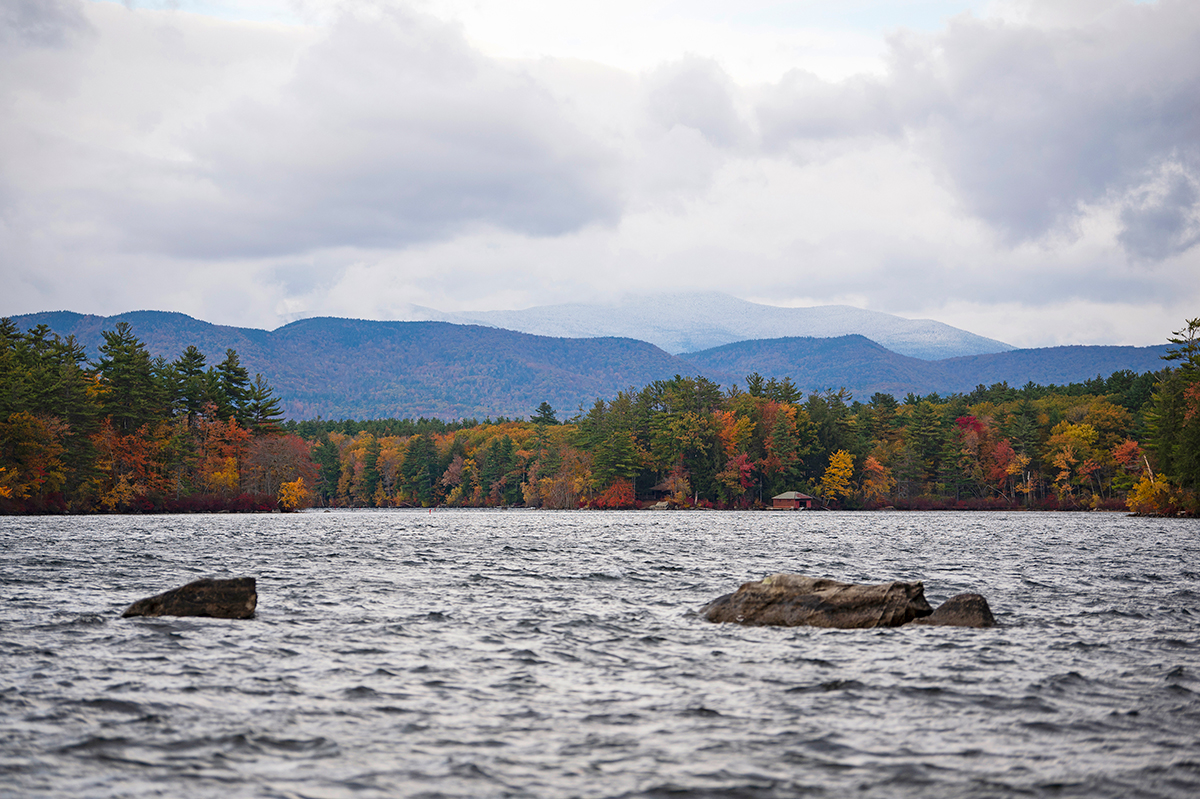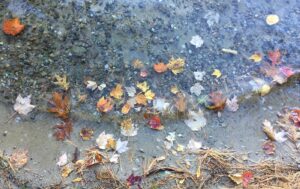NEFF and partners recently celebrated 65 years of conservation success in the Squam Lakes Region
Writing by Frank Lowenstein, photography by Tinsley Hunsdorfer
The Squam Lakes sit just south of the rugged southern ramparts of the White Mountain National Forest. Reflections of the forested slopes of Mounts Whiteface, Osceola, and Passaconaway shimmer off the lake’s waters, which draw visitors from around the world. Famously, the 1981 blockbuster On Golden Pond was filmed here, starring Katherine Hepburn, Henry Fonda, and his daughter Jane Fonda, who played the role of their fictional daughter. Like Jane Fonda, Squam Lake pretty much played itself—appearing as a beautiful and beloved New England pond.

The view of Squam Lakes from NEFF’s Chamberlain Reynolds Memorial Forest, photo by Tinsley Hunsdorfer
New England Forestry Foundation has had a role in conservation of the lake and its watershed since 1953, when John Wister donated the Chamberlain Reynolds Memorial Forest to NEFF—the first conservation land along the lake and indeed in the entire watershed. The property encompasses a peninsula that reaches out into the lake, giving it nearly a mile of shoreline. Coves along its shore give a feeling of seclusion, and the forest tends to tall pines, oaks and hemlocks that provide a shady and peaceful context. All summer long campers occupy tent sites managed by Squam Lakes Association (SLA), part of a decades long partnership with NEFF. Swimmers and boaters flock to the publicly accessible beaches on the lake along the property’s southwest edge. Many forms of wildlife make their homes there, including loons that regularly nest in Heron Cove.
On October 20, 2018, the Squam Lakes community joined NEFF staff and Board of Directors members to celebrate the Chamberlain Reynolds Memorial Forest as another step was taken to safeguard the land. John Wister’s 1953 deed to NEFF was vague and at times contradictory as to his intent. In September, NEFF voluntarily registered a Declaration of Trust with the State of New Hampshire, committing NEFF to never develop the property and pledging to keep the property in its natural state, just as the organization has done for the past 65 years.
“NEFF has once again proven they are conservation leaders and terrific partners,” said Roger Larochelle, Executive Director of the Squam Lakes Conservation Society (SLCS). “This Declaration of Trust settles any lingering question of limited development, and ensures this property will remain an iconic and invaluable natural treasure for all.”
Today, thanks to private conservation efforts led by groups such as SLCS, land conservation in the watershed has blossomed. Fully 30 percent of Squam’s land is now permanently conserved. Many of those conserved lands offer breathtaking views of the lake and its mountainous backdrop. West Rattlesnake Mountain, for example, provides a near view of the lake from ledges a few hundred feet above the water—attracting hikers and photographers year-round. NEFF’s lands in the watershed are also heavily visited. These three NEFF forests and their vistas are well worth exploring: Whitten Woods Community Forest high on the watershed’s western edge, the Newsom and Stevens Memorial Forests that front on Little Squam Lake, and Chamberlain Reynolds Memorial Forest—considered by many to be the crown jewel of the watershed’s conservation lands.
NEFF’s properties also show just what Exemplary Forestry can do. For example, NEFF has conducted 10 harvests at Chamberlain Reynolds since 1953, extracting 1.1 million board feet of lumber, an amount that could build 22 single-family homes. Yet the property today has a third more standing timber on it than when it was donated, and looks nearly undisturbed. This is a living testament to the benefits of working with professional foresters. NEFF currently works with Peter Farrell of the New England Forestry Consultants. Peter has managed Chamberlain Reynolds since 1994 when he took over after the unexpected passing of his colleague, Mike Burke.
 When one walks the property, magnificent pines and oaks shadow the trails leading to the beaches. Hemlocks that germinated before the American Revolution cling to boulders and wait their own turns in the canopy. Pines that reached the end of their natural life span and died in place now provide homes for woodpeckers, owls and other birds that nest in cavities. Here and there, interpretive signs identify the sites of previous harvests where the growth of the next generation of trees is already underway. A boardwalk crosses a pristine and rare shrub swamp, full of plants that one doesn’t find in most nurseries, such as leatherleaf and maleberry. And along the property’s beaches in fall one can read the history of the wind and the trees, as leaves of different species wash up in distinct bands, reflecting different winds and waves when each species’ leaves fell into the water.
When one walks the property, magnificent pines and oaks shadow the trails leading to the beaches. Hemlocks that germinated before the American Revolution cling to boulders and wait their own turns in the canopy. Pines that reached the end of their natural life span and died in place now provide homes for woodpeckers, owls and other birds that nest in cavities. Here and there, interpretive signs identify the sites of previous harvests where the growth of the next generation of trees is already underway. A boardwalk crosses a pristine and rare shrub swamp, full of plants that one doesn’t find in most nurseries, such as leatherleaf and maleberry. And along the property’s beaches in fall one can read the history of the wind and the trees, as leaves of different species wash up in distinct bands, reflecting different winds and waves when each species’ leaves fell into the water.
Across the watershed at its western edge, Whitten Woods is NEFF’s largest property in the Squam region, encompassing 577 acres. Again, partnership was key to conservation. NEFF joined with Squam Lakes Conservation Society to protect the property, and SLCS holds and monitors conservation easements on NEFF’s lands at the site. From the access point on Highland Street not far from the Ashland exit off Interstate 93, trails maintained by SLA lead quickly to a high vista looking northeast to the Squam Lakes and the mountains beyond. Here the forest is young, and heavy to regenerating birch and maple; NEFF’s management will aim to restore the productive capacity of a landscape heavily harvested by previous owners. Here the trails offer more rigor than the relatively flat, needle-covered paths that lead one through Chamberlain Reynolds Memorial Forest. A lumpy and rocky ridge extends north-south through the center of the property, rising 700 feet from the valley of the Pemigewasset River west of the property. Plans are underway to include an accessible trail to the view sites.
In the Lakes Region of New Hampshire, where the Squam Lakes and Lake Winnipesaukee are merely the largest among many, NEFF protects 10 Community Forests totaling 5,045 acres, and another 1,989 acres of conservation easements, a great example of the success of private conservation. Although the White Mountain National Forest to the north was protected through public action, nearly all the protection in the Squam watershed was accomplished by private non-profit organizations like NEFF that depend on donor generosity for their success. SLCS, SLA, NEFF, New Hampshire Audubon Society, the Forest Society and other groups have created a conservation mosaic that protects the lake and its watershed, preserving water quality and providing access to some of the most breathtaking views in New England. NEFF is proud to be a partner in this effort.
